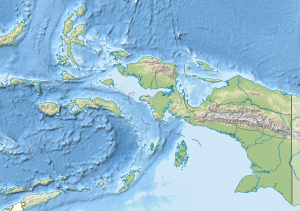Run (Banda Islands)
| run | ||
|---|---|---|
| Run Island in the west of the Banda Islands | ||
| Waters | Banda Lake | |
| Archipelago | Banda Islands | |
| Geographical location | 4 ° 33 '26 " S , 129 ° 41' 2" E | |
|
|
||
| length | 3 km | |
| width | 1 km | |
Run (Indonesian: Pulau Run, also Rhun) is one of the smallest Banda Islands .
She was known in the early modern period for growing nutmeg , the gold of the East Indies .
geography
Run belongs to Indonesia , lies in the Banda Sea , is three kilometers long and one kilometer wide. It is the westernmost of the Banda Islands; The neighboring island of Ai is about 7 km to the east. 700 m to the north is the small, approximately 200 m long islet Pulau Nailakka.
history
In 1603 the island was discovered by James Lancaster , John Davis and John Middelton on a spice exploration trip paid for by the British East India Company . First contacts with the locals were peaceful. The English settled on Nailaka. On December 25, 1616, the island was occupied by Captain Nathaniel Courthope in order to defend it against claims by the Dutch, represented by the Dutch East India Company . An agreement signed with the locals also confirmed the sovereignty of the British Crown over the area. After the Dutch had besieged the island for four years and Nathaniel Courthope was killed in an ambush in 1620, the English and their native allies left the island without a fight.
After the Peace of Westminster , which ended the First Anglo-Dutch War , the island was to be returned to the British Crown. However, this failed in 1660 due to formal disputes, and the island remained in Dutch possession. In 1665 the English traders were finally driven out and the nutmeg trees felled. In the Peace of Breda (1667), which was concluded after the Second Anglo-Dutch War , the Dutch finally received the island in exchange for the island of Manhattan , which had been occupied by the British during the war.
Spice trade
The island was considered incredibly rich by Europeans because it was overgrown with nutmeg trees. The profit margins in trading in nutmegs reached astronomical heights of up to 60,000%, especially when it was rumored that the nut helped against the plague . By exchanging the last nutmeg island, which they did not own, for Manhattan, the Dutch were able to secure the monopoly on nutmeg cultivation. This monopoly was only ended in 1770 with the kidnapping and planting of some trees in Africa by Pierre Poivre .
literature
- Giles Milton: Nutmeg and Muskets. Europe's race to the East Indies . Zsolnay, Vienna 2001, ISBN 3-552-05151-1 (German edition of Nathaniel's Nutmeg. How One Man's Courage Changed the Course of History. London 2000)
Web links
Individual evidence
- ^ Vincent C. Loth: Pioneers and Perkeniers: The Banda Islands in the 17th Century . (PDF)
- ^ Timeline Indonesia. ( Memento of the original from July 10, 2010 in the Internet Archive ) Info: The archive link was inserted automatically and has not yet been checked. Please check the original and archive link according to the instructions and then remove this notice.


